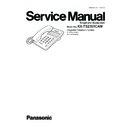Panasonic KX-TS2361CAW Service Manual ▷ View online
5
KX-TS2361CAW
2.1.1.
Suggested PbF Solder
There are several types of PbF solder available commercially. While this product is manufactured using Tin, Silver, and Copper
(Sn+Ag+Cu), you can also use Tin and Copper (Sn+Cu) or Tin, Zinc, and Bismuth (Sn+Zn+Bi). Please check the manufacturer’s
specific instructions for the melting points of their products and any precautions for using their product with other materials.
The following lead free (PbF) solder wire sizes are recommended for service of this product: 0.3 mm, 0.6 mm and 1.0 mm.
(Sn+Ag+Cu), you can also use Tin and Copper (Sn+Cu) or Tin, Zinc, and Bismuth (Sn+Zn+Bi). Please check the manufacturer’s
specific instructions for the melting points of their products and any precautions for using their product with other materials.
The following lead free (PbF) solder wire sizes are recommended for service of this product: 0.3 mm, 0.6 mm and 1.0 mm.
2.2.
Discarding of P.C. Board
When discarding P. C. Board, delete all personal information such as telephone directory and caller list or scrap P. C. Board.
0.3 mm X 100 g
0.6 mm X 100 g
1.0 mm X 100 g
6
KX-TS2361CAW
3 Specifications
Note:
• Design and specifications are subject to change without notice.
Power Source:
Redial:
Speaker:
Speaker:
Microphone:
Dimensions (H x W x D):
Dimensions (H x W x D):
Weight:
Dial Mode:
From telephone line
Last dialed telephone number
Handset; 3 cm (1 ) PM dynamic type, 150
Handset; 3 cm (1 ) PM dynamic type, 150
Electret condenser microphone
Appr
Appr
ox. 95 mm x 167 mm x 224 mm
Approx. 590
Tone (DTMF)/Pulse (10 pps)
g
7
KX-TS2361CAW
4 Technical Descriptions
4.1.
Block Diagram
RI
NG
E
R
IC
Li
ne
ON
/O
F
F
Tr
ans
m
it
Am
p
H
ands
et
A
m
p
R
ec
eiv
in
g
H
ands
et
A
m
p
S
endi
ng
K
ey
boar
d
Sw
itc
h
Ringer
Handset
Q4, Q6, Q7
Q3
Q1, Q2,Q22
D1
LINE
T
R
IC2
DIALE
R
IC
IC1
C1
R1
Q9
Speaker
Mic
KX-TS2361: BLOCK DIAGRAM
8
KX-TS2361CAW
4.2.
Circuit Operation
4.2.1.
Telephone Line Interface and Pulse Dial Circuit
When the hook switch SW1 is ON (off-hook), the circuit is closed, and current is supplied to the base of Q2 via the diode bridge
D1 and Q2 is On
D1 and Q2 is On
Q1 is ON (OFF-HOOK condition).
Q1 and Q2 are the dial pulse generating circuits, and are driven by the DIALER (IC1), when the DIALER Pin 10 of IC1 is LOW
Q2 is OFF and Q1 is OFF. (break) If port Pin 10 is HIGH Q2 is ON Q1 is ON. (make)
Q2 is OFF and Q1 is OFF. (break) If port Pin 10 is HIGH Q2 is ON Q1 is ON. (make)
4.2.2.
Tone Dial Circuit
4.2.2.1.
Function
The tone dialing circuit consists of a DTMF (Dual Tone Multi Frequency) signal generator (outputted from Pin 11 of the IC1) for
tone dialing, and also a circuit for outputting the signal to line.
The DTMF circuit identifies inputs from the 12 keys (1,2,3,4,5,6,7,8,9,0, and #) by means of a total of seven frequencies, that
is four low frequencies (Low group) and threehigh frequencies (High group).
tone dialing, and also a circuit for outputting the signal to line.
The DTMF circuit identifies inputs from the 12 keys (1,2,3,4,5,6,7,8,9,0, and #) by means of a total of seven frequencies, that
is four low frequencies (Low group) and threehigh frequencies (High group).
4.2.2.2.
Circuit Description:
When a dial key is pressed, a DTMF signal is output from Pin 11 of IC1 as an analog synthetic wave.
The signal flow to the line is as follows.
Pin 11 of IC1
The signal flow to the line is as follows.
Pin 11 of IC1
VR3 Q9 Q3 Q1 Tel Line.
The DTMF signal is sent to the line via the following path. Q9 and Q3 is an amplifier which is used to output the signal to line.
Shown below is the signal flow used to output the DTMF signal from the handset as a monitor tone when a dial key is pressed.
Pin 11 of IC1
Shown below is the signal flow used to output the DTMF signal from the handset as a monitor tone when a dial key is pressed.
Pin 11 of IC1
R48 C33 Q7 C18 Handset Speaker.
4.2.2.3.
Tone Frequencies
4.2.3.
Ringer Circuit
4.2.3.1.
Circuit Operation
The bell signal passes through C1 (R1)
supplying power to pin 1 of IC2.
The ring signal is output from Pin 5 of IC2, and its volume is adjusted in 3 steps (H-L-OFF) by SW3 then impressed on the
ceramic sound generator, and so is generated.
Output frequency is controlled by R2 and C3 following below formula.
ceramic sound generator, and so is generated.
Output frequency is controlled by R2 and C3 following below formula.
High Group
Low Group
H1 H2 H3
L1
1
2
3
L2
4
5
6
L3
7
8
9
L4
0
#
Low Group Frequencies High Group
Frequencies
L1
697 Hz ± 1.5%
H1
1209 Hz ± 1.5%
L2
770 Hz ± 1.5%
H2
1336 Hz ± 1.5%
L3
852 Hz ± 1.5%
H3
1477 Hz ± 1.5%
L4
941 Hz ± 1.5%
-----
-----
f
2
= 0.725 f
1
fswcep =
750
C3 (nF)
R2 =
2 + 72 +10
4
f
2
(CH2)
x (1 - 0.04ln )
1943
f
1
Click on the first or last page to see other KX-TS2361CAW service manuals if exist.

